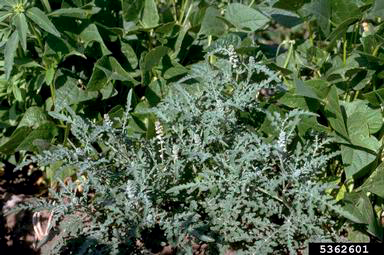
EPPO Alert List – Ambrosia grayi (Asteraceae)
Why
In the EPPO region, Ambrosia grayi (Asteraceae) is currently confined to a small area (approximately 4 ha) in Israel, where the species is considered transient. The EPPO Panel on Invasive Alien Plants are seeking further information on any additional occurrences of A. grayi in the EPPO region and any reports of environmental and economic impacts.
Geographical distribution
EPPO region: Israel.
North America: Mexico, USA (Colorado, Kansas, Nebraska, New Mexico, Oklahoma, Texas).

Ambrosia grayi growing among dry bean plants.
Howard F. Schwartz, Colorado State University, Bugwood.org
Morphology
Ambrosia grayi is a monoecious, perennial species 10–30 cm tall. Stems are erect. Leaves are mostly alternate and the petioles are 10–45+ mm; blades are elliptic to ovate. The female inflorescences are greenish and the stigma visibly protrudes from the female flower structure. Achenes (burs) have approximately ten hooks, which may be slightly curved or straight. Each achene typically contains one or two seeds enveloped in a dark, easily removable seed coat.
Biology and Ecology
In the USA, A. grayi can reproduce by both seed and rhizome, with the later extending up to 3 m deep in the soil. However, in Israel, sexual reproduction is considered unlikely to significantly contribute to the spread of the species. Rhizomes may remain in a dormant state in dry soils and dormancy can be broken when the soil moisture content increases to a range from 25 % to 60 %.
Habitats
In its native range, A. grayi can be found growing in wet or seasonally wet grasslands. In addition, it is found along roadsides, ditches and agricultural fields. In Israel, A. grayi is found in open fields and under tree canopies in fruit orchards.
Pathways for movement
It is not known how A. grayi entered the EPPO region. However, the burs can attach themselves to clothes, people and animals (e.g. livestock).
Impacts
In the USA, A. grayi is a weed in agricultural systems in the central and southern Great Plains. In Texas, A. grayi is considered a highly competitive species in crops such as cotton and sorghum.
Control
Chemical control methods can be effective in controlling A. grayi though the timing of application is critical for effectiveness. Additionally, repeated applications may be required to control populations.
Sources
Neta D, Abu-Nassar A,, Cafri D, Ezra N, David I, Shtein I, Goldway M, Elzenberg H, Matzrafi M (2024) Ambrosia grayi as a new alien causal species in Israel: plant biology and chemical management. Pest Management Science. https://doi.org/10.1002/ps.8048
Yair Y, Sibony M, Confino-Cohen R, Rubin, Shahar E (2019) Ragweed species (Ambrosia spp.) in Israel: distribution and allergenicity. Aerobiologia 35, 85-95.
